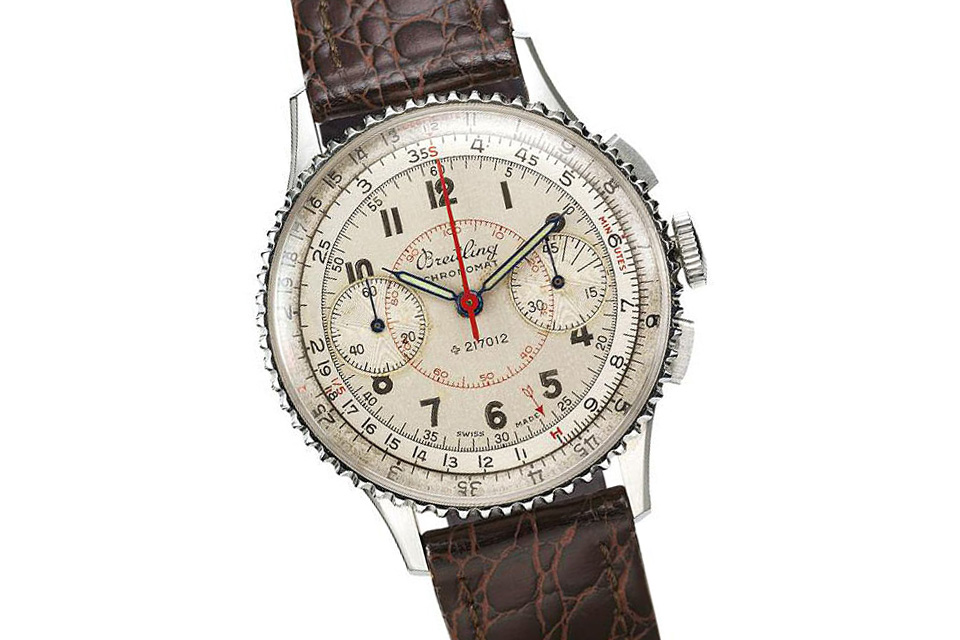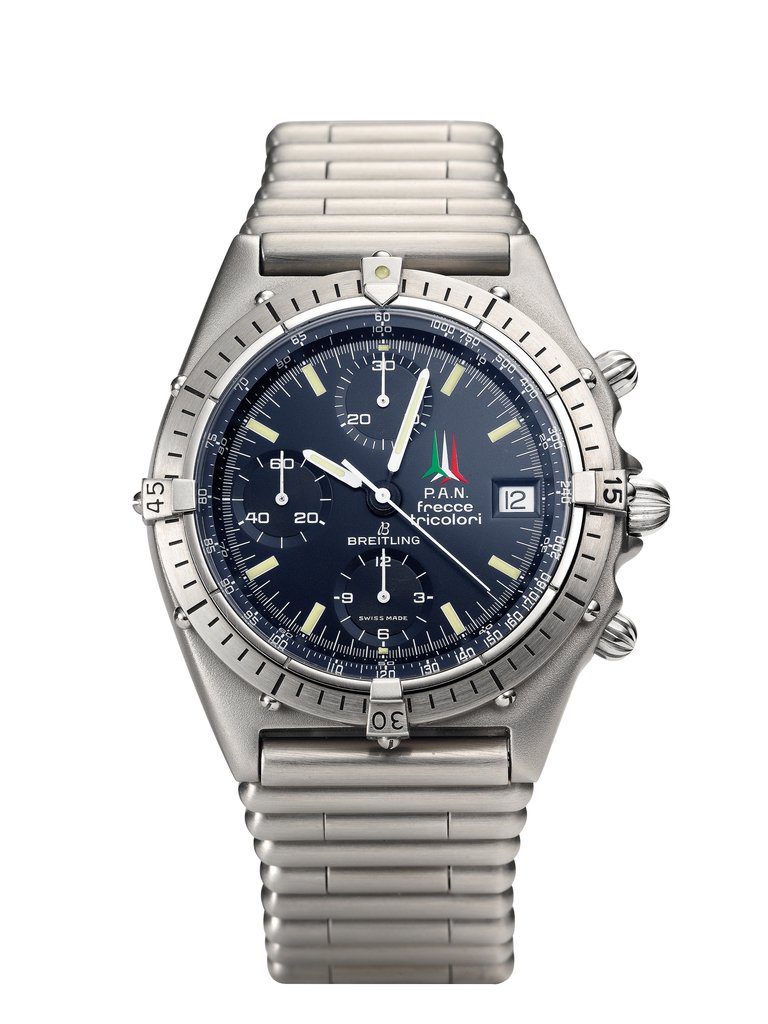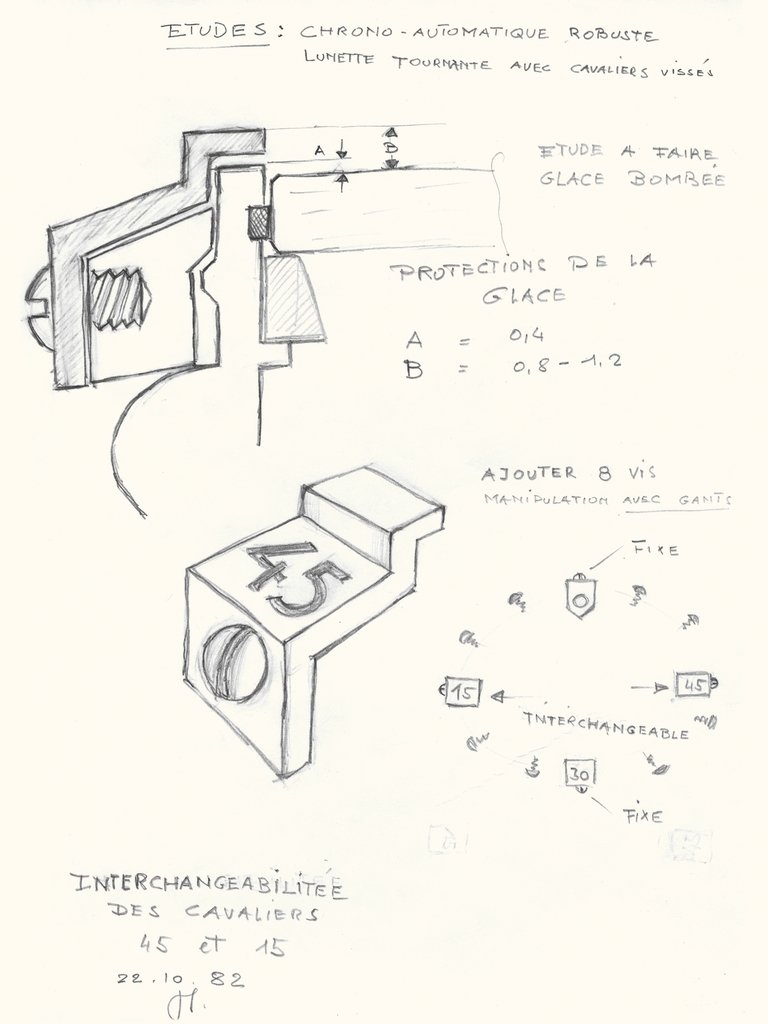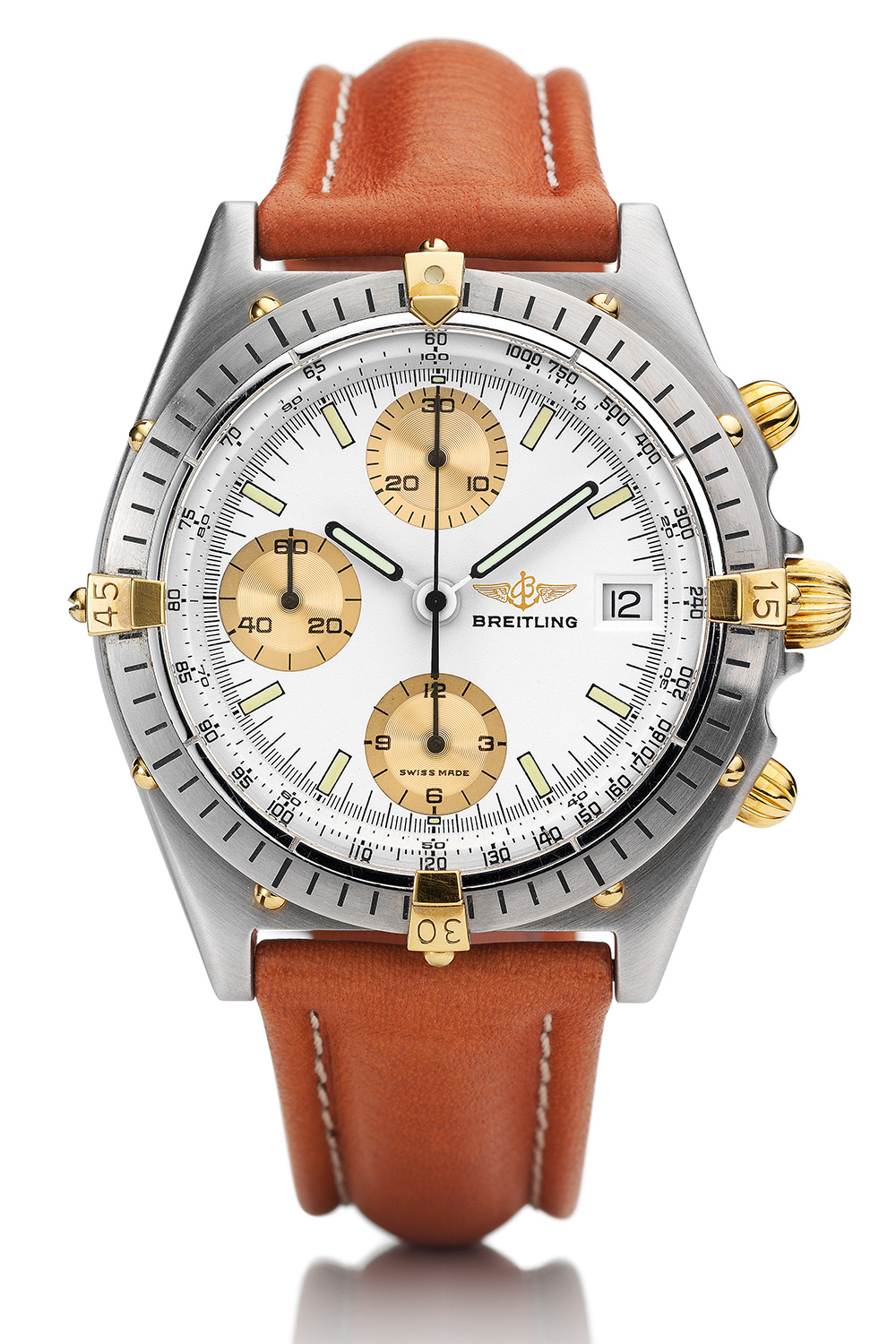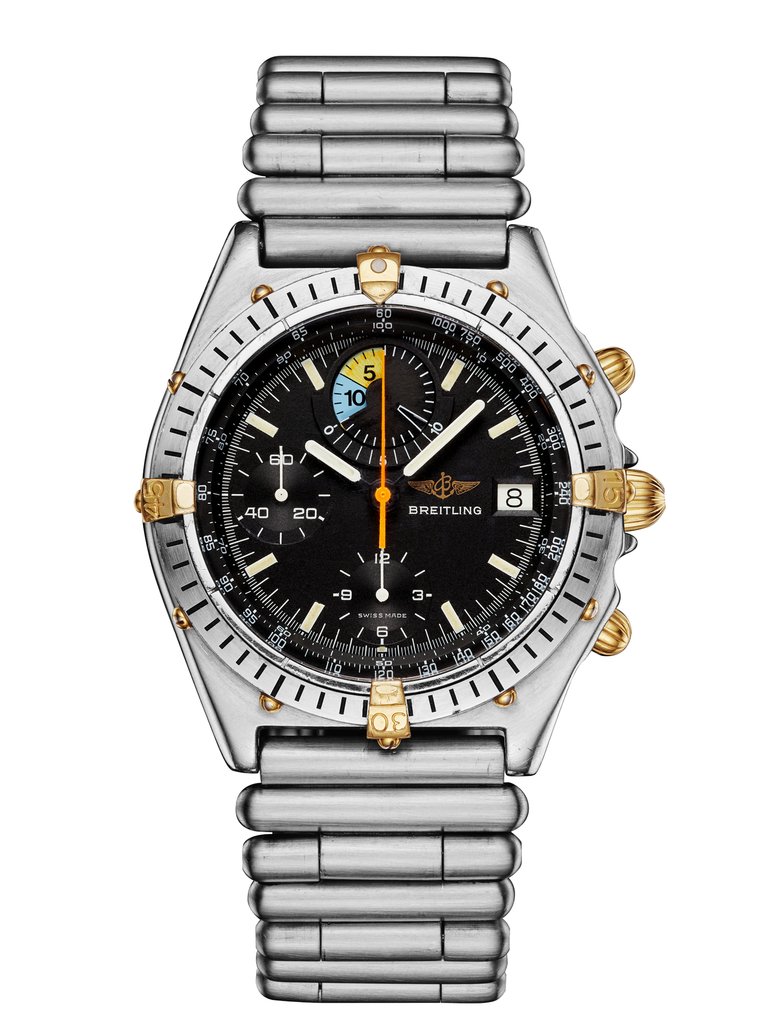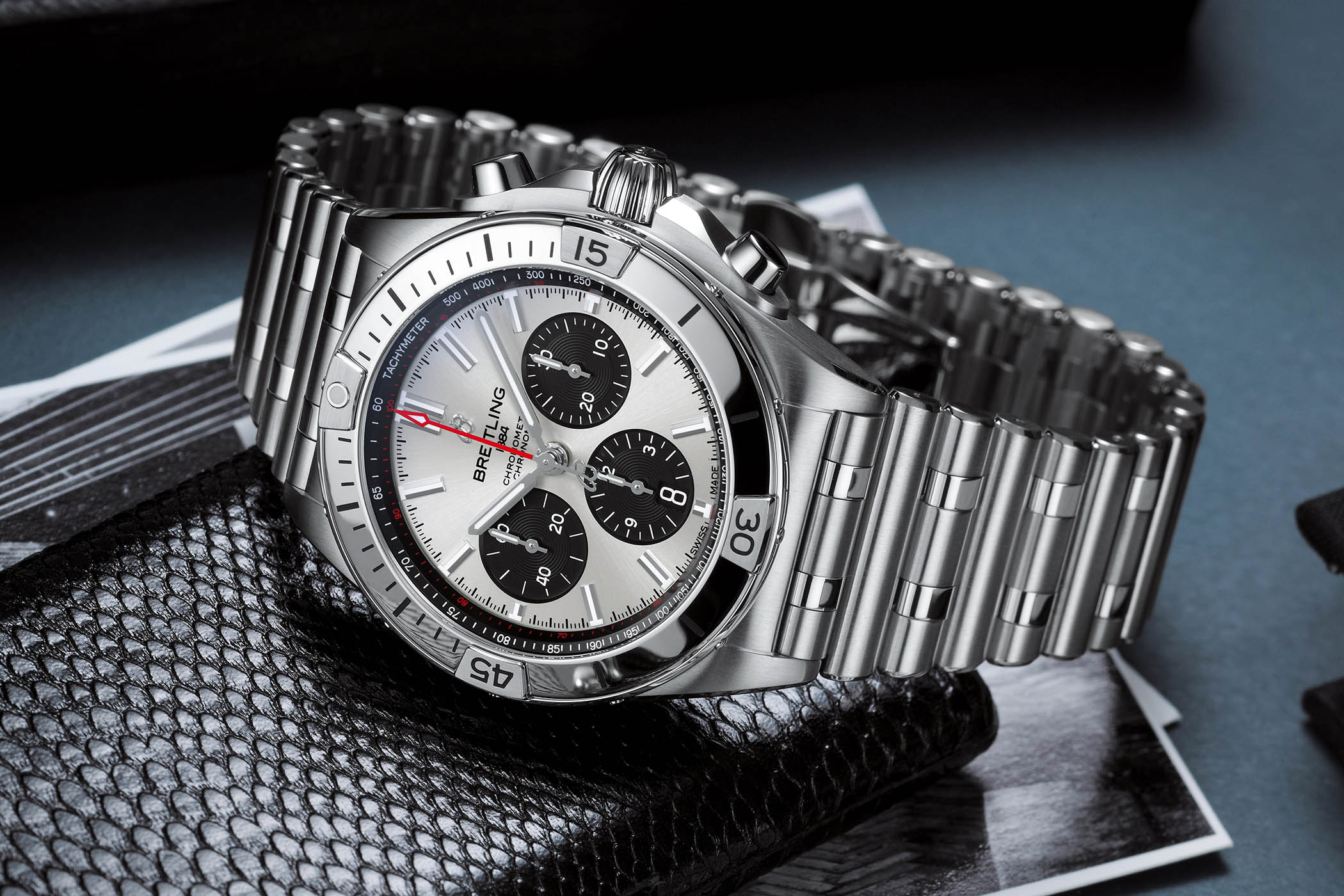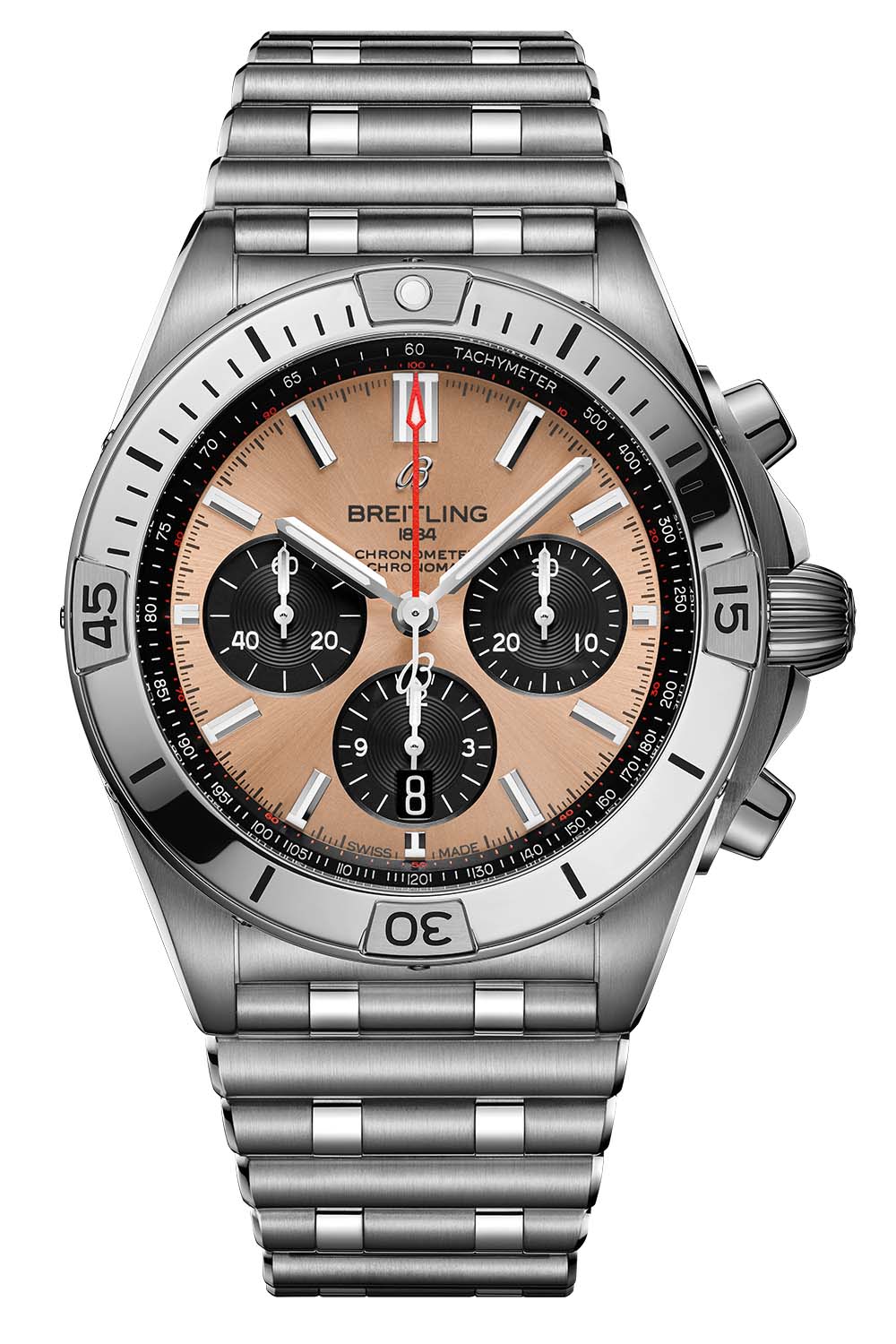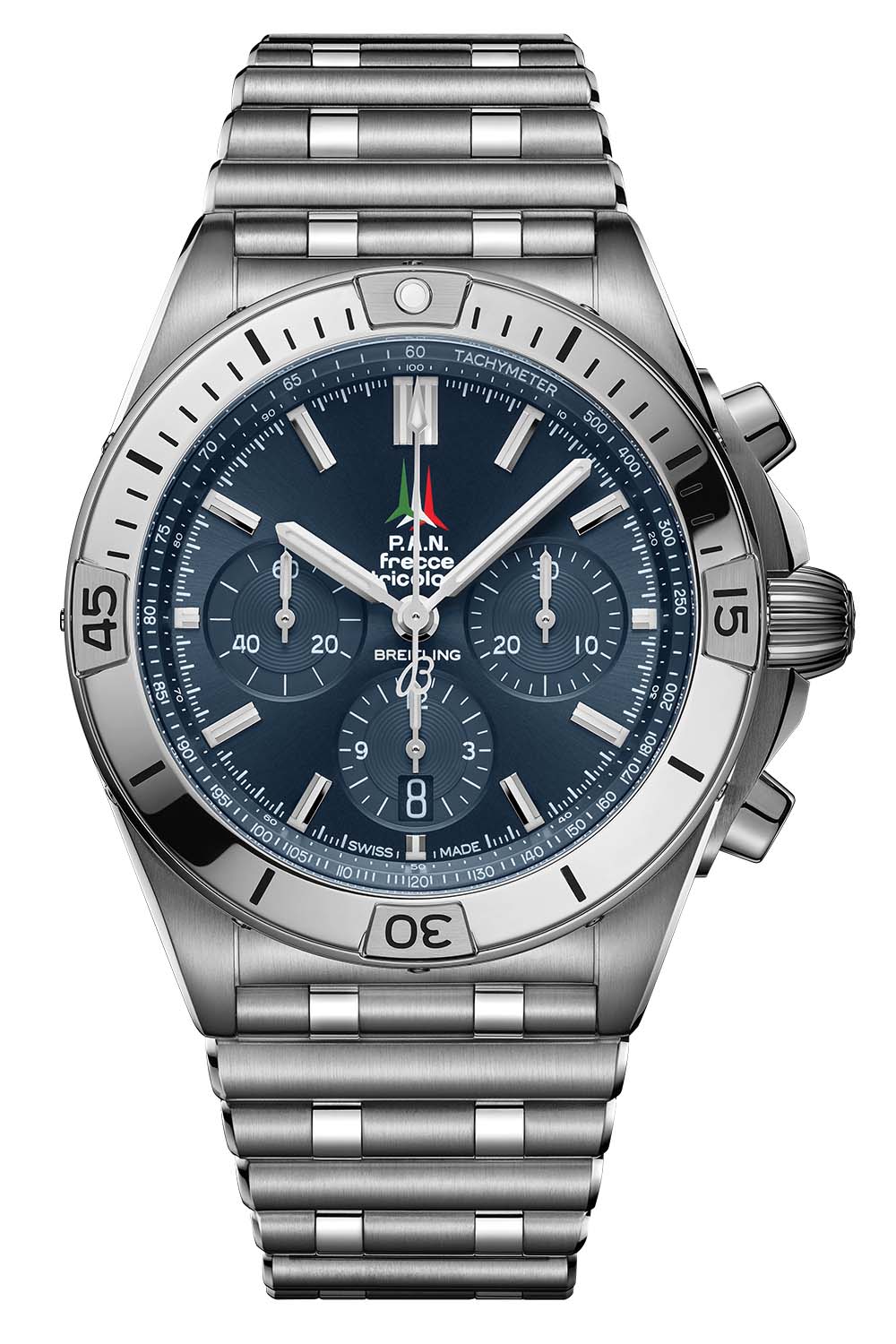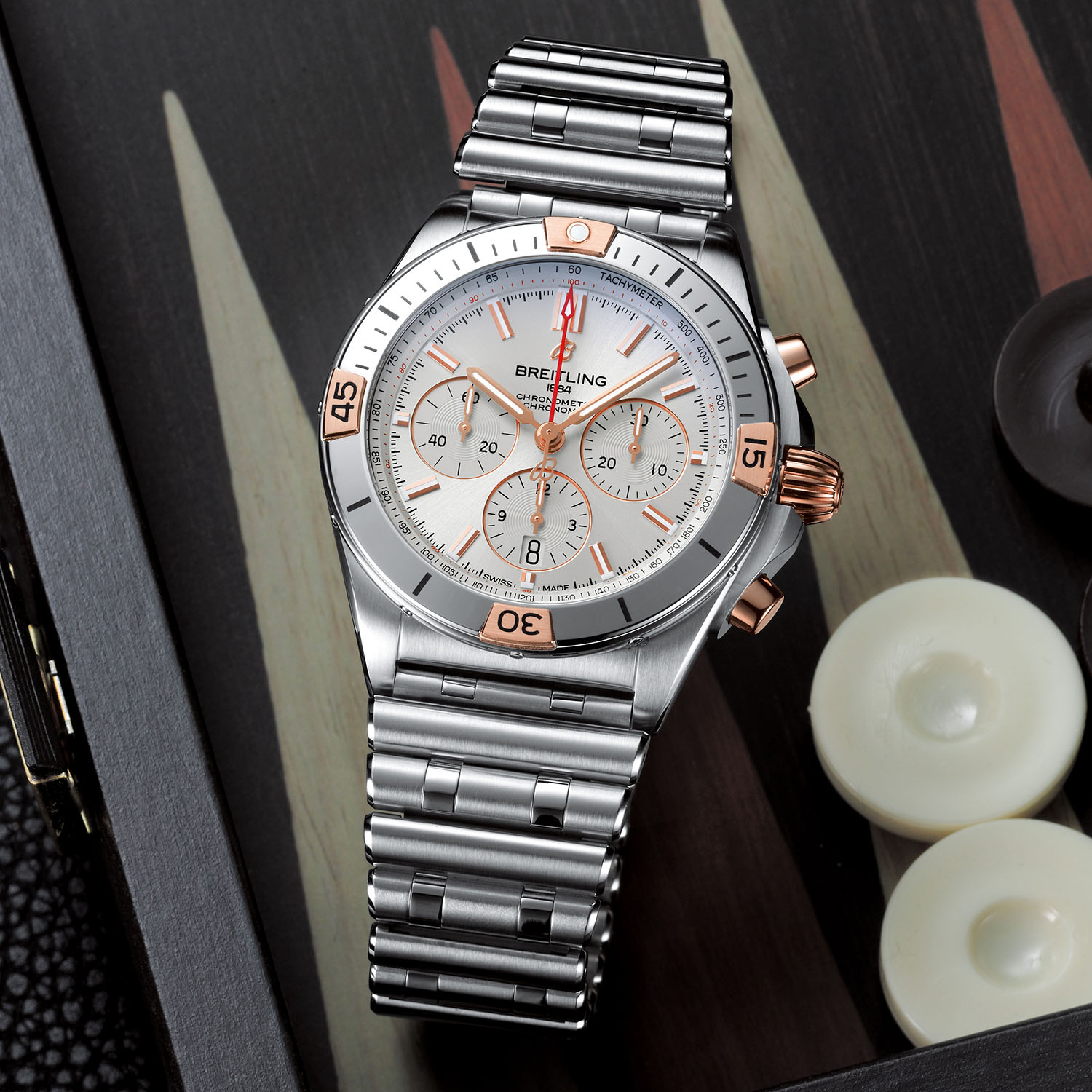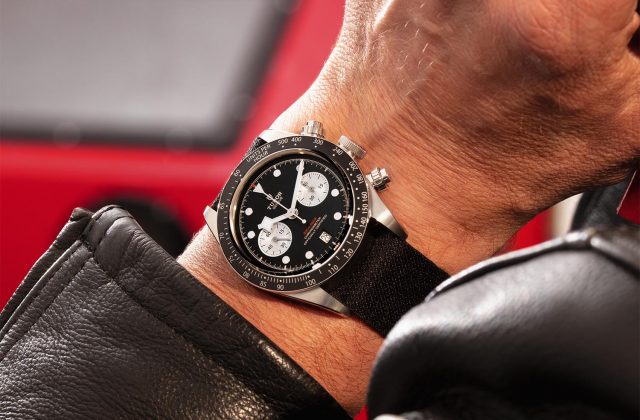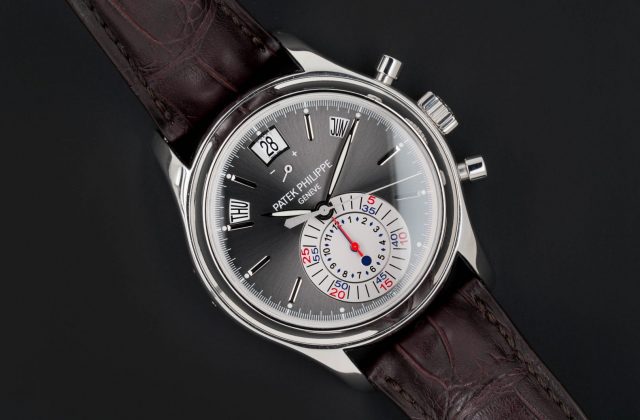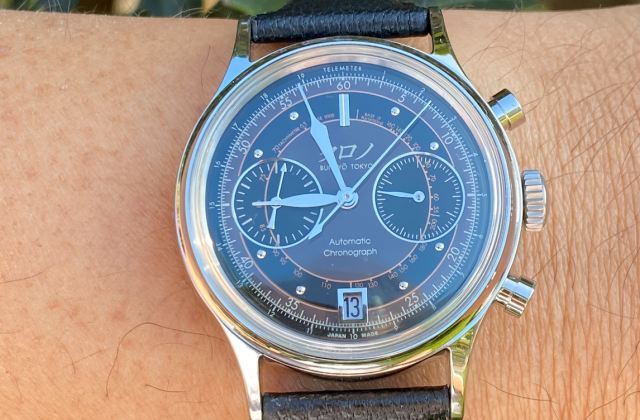This is the Breitling Chronomat B01 42. Refreshed in 2020, this is the watch that in many ways started it all. Well, re-started. Born in the 1980s in the aftermath of the quartz crisis, the Chronomat became a best-seller for the brand. And in the process, helped make mechanical chronographs cool again. Its outstanding success not only revived the fortunes of Breitling. It helped revitalize an entire industry. Not bad for a steel watch with an outsourced movement. Nowadays, of course it looks quite different. And it’s powered by a manufacture movement. But it still has that same Chronomat pioneering spirit. Want to know the full story? Keep on reading.
A (Very) Brief History Of The Chronomat
Today, the Chronomat collection comprises ultra-modern chronographs. In reality though, the Chronomat name dates back to 1940. That’s the year Breitling applied for a Swiss government patent for a circular slide rule. One that could operate in conjunction with a wrist chronograph. The name was a combination of “chronograph” and “mathematique”. Emphasising the model’s focus on the field of engineering and mathematics.
The first Chronomats would go into production in 1941 and sold well. So well in fact that they inspired the creation of another model. One created for the specific needs of commercial pilots. The Navitimer. Nowadays most people associate the slide rule bezel with that iconic model. But it was actually the Chronomat that started it all.
- An early example of the Breitling Chronomat from 1941
The Chronomat was also one of the models chosen to debut the first automatic chronograph. Developed in the 1960s in partnership with Breitling, Buren, Dubois Depraz, and Heuer. That little project also led to the creation of the Heuer Monaco. Another chronograph-equipped icon.
Unfortunately for Breitling though, it wasn’t enough. By the mid-1970’s the Quartz crisis was well underway and casualties were piling up. Even despite playing a strong role itself in the evolution of quartz watches. In 1978, all watch production ceased at the company and a for sale sign put in the window. It didn’t take long for Mr Ernest Schneider to snap up the opportunity in 1979. He had big plans for the company and began releasing new models the very next year.
The Frecce Tricolori
The Chronomat was not among these first models though. It would be four more years before it made its triumphant return to the Breitling portfolio. And by then, it looked very different thanks to a special collaboration the year before.
As an astute businessman, Schneider was always on the lookout for new ways to promote his company. He was also an avid pilot. Two factors which led to a unique partnership with the famed Frecce Tricolori. The aerobatic demonstration team of the Italian Air Force. In the early 1980s the squad was looking for a new chronograph for its pilots. One that could meet some specific criteria.
- The Breitling Chronomat Frecce Tricolori from 1983.
The watch needed to be elegant enough to wear with a suit when the pilots were off-duty. They were Italian gentleman after all. But still durable enough to withstand repeated use in a jet cockpit. The elite aerobatics team also wanted an analog display, which meant it had to be a mechanical watch. (No quartz chronograph movement of this type was yet available on the market.)
During the conception phase, Schneider met with the Italian squad several times. It was during one such meeting that he learned of a pain point for the pilots. Their watches would knock against the frame when they opened the jet’s canopy after landing. Sometimes resulting in broken watch crystals. This led to the idea of recessing the crystal and protecting it with a bezel with four “rider tabs”.
Placed at every quarter hour, the tabs offered added timekeeping functionality as well. You could even unscrew the tabs at 15 and 45 and invert them. Making it possible to use the bezel for countdown or count-up timings. The tabs also had the added advantage of being easy to grip while wearing gloves. This distinctive design would become the iconic signature of the Chronomat. Breitling applied the same logic to the pushers and crown. Making them knurled and more prominent for ease of use. Onion-style crowns were common on pilot’s watches from the 1930s and ’40s. Zenith use a similar design for their Pilot Type 20 Extra Special.
- A sketch of the original Rider Tabs design conceived by company owner Ernest Schneider.
Another distinguishing feature of the Frecce Tricolori Chronomat is its bracelet. Christened the “Rouleaux” bracelet, it’s formed from long, cylindrical links with rounded tips. This “roller’ design ensured it would be comfortable on a pilot’s wrist for long periods of time. There was nothing else on the market like it. And it looked damn cool as well.
Inside the 39mm case was the ETA Valjoux 7750 chronograph movement. One of the best-known chronograph movements of the era. It’s lever-style chronograph was reliable and designed for mass production. Leading it to play a critical role in the resurgence of mechanical watches in the 1980s.
The Navitimer Chronomat
With the completion of the Frecce Tricolori project, Schneider knew he had a winner on his hands. This new chronograph embodied the brand’s entire philosophy and mission. Since buying the company in 1979 he had been dreaming of launching such a watch. One that would revolutionise and revive this battered industry. Remind people of what Breitling did best. And, most important of all, win back the hearts and minds of watch lovers.
In 1984, Breitling released the Navitimer Chronomat to mark the brand’s centenary. It retained many of the design elements of the professional version. And while the name was the same as before, it now represented something else. “Chronograph” and “automatic”, emphasising its self-winding calibre. Which at that time was still the ETA Valjoux 7750.
- A two-tone version from 1984.
This hefty mechanical chronograph flew in the face of the slim, time only trend of the time. But it proved to the exactly the shot in the arm the industry needed. Enjoying global success, it helped reignite the desire for mechanical watches. And mechanical chronographs in particular. (On which Breitling had built its reputation.)
It was so successful in fact that it went on to become Breitling’s best-selling model. Within a couple of years, it had stepped out of the Navitimer’s shadow. In 1987, the Chronomat was big enough to become its own collection.
- Breitling also made a special “Yachting” version of the Chronomat in the 1980s. Low production volumes means these are now sought after by collectors.
In some ways though, the Chronomat became a victim of its own success. With so many variations made, it became ubiquitous. (By the 1990s there were well over a thousand iterations available.) Less associated with fine watchmaking and quality craftmanship. And more so with excess and poor taste. That’s all changed now though. In large part thanks to one man.
The Modern Chronomat
When Georges Kern became CEO of Breitling in 2017, the company looked very different. Today the collections are more streamlined, with defined collections and target audiences. Back then though, things were a bit more chaotic. Over the years the various product lines had become convoluted. This led to a very broad range of products, targeted at a very narrow market. Kern summed it up as “visual pollution.”
“The brand was much too complicated,” he said at the time. “So many rubber straps at Breitling, it was confusing. You’re knocked out by the visual complexity. Too much choice is no choice.”
His strategy to combat this was two-fold. Slim down the collections by shedding a bunch of references. And organize them into clear pillars; air, land, sea and elegance. With the Navitimer occupying the air pillar, the focus of the Chronomat shifted to land. It became Breitling’s go to watch for rugged everyday wear. In 2020, the collection underwent a full refresh in 2020. With the results both surprising and impressing watch lovers everywhere.
The Breitling Chronomat B01 42
Presented in a wearable 42mm steel case, the new Chronomat B01 42 took a lot of people by surprise. (Although it is a little on the thick side at 15.10mm.) It still has the distinctive hallmarks of the original model from the 1980s. Such as the rider tabs on the bezel. The onion-shaped crown. And, of course, the Rouleaux bracelet. But there’s a sense of refinement that was missing from earlier models. And Breitling watches in general pre-Kern, if we’re being honest.
For example, the rider tabs on the new Chronomat are less prominent. They are broader and flatter, and less polarising than earlier models. Yet they still provide the same functionality of the original design. That includes the ability to invert the ’15’ and ’45’ tabs. Although Breitling now recommends you have this done in store.
The balanced dials feature central time displays and contrasting 3-6-9 sub-register layouts. The date appears via an aperture at 6 o’clock. The central chronograph seconds hand is in red and pairs with a tachymetre scale on the dial flange. To be honest it’s all standard fair but it re-positions the Chronomat as a rugged yet stylish tool watch. In the same spirit as the original Frecce Tricolori model. Although updated for modern tastes.
Speaking of which, the collection also features a Chronomat Frecce Tricolori Limited Edition. A subtle affair, it pairs a blue a dial with tone on tone sub-dials. Unlike the other models, it uses a silver central chronograph hand. I quite like the styling of this one and the only thing that indicates it’s special is the Frecce Tricolori logo. It replaces the standard Breitling logo beneath 12 o’clock. Limited to 250 pieces, the caseback has the words “ONE OF 250” engraved.
- The limited edition Frecci Tricolore Chronomat B01 42
For the non-limited versions in steel, there are four dial colours to choose from. Silver, copper, or blue with black contrasting chronograph counters. Or black with silver contrasting chronograph counters. There are also bi-metal versions in steel and 18k red gold. As well as a full 18k red gold version if you’re feeling opulent. And to round things out, there is a Chronomat Bentley edition with green dial.
All models come on the redesigned Rouleaux bracelet with a butterfly clasp. It’s won a lot of fans already thanks to its distinct looks and comfort on the wrist. There still is isn’t anything quite like it on the market and it helps put the new Chronomat over the top. It’s not a true integrated bracelet, but it’s pretty close. And it lends itself to dressing up or down.
Inside the 200m water resistant case is the in-house, Breitling Manufacture Caliber 01. A column-wheel chronograph that uses a vertical coupling system. This was Breitling’s first in-house movement, launched back in 2009. In the Chronomat 01 no less. Its modular design makes it easier to service and also to build on. This self-winding movement uses a single barrel to deliver a power reserve of about 70 hours. Making it “weekend proof” as they say. Chronometer-certified, it offers a 1/4th second chronograph, with 30-minute and 12-hour totalizers. The movement is visible through a sapphire display back.
Price & Availability
Pricing on the Breitling Chronomat B01 42 starts from US$8,100 for the steel, non-limited versions. It heads north from there to around the US$20,000 range for the full gold models. The watches are available from Breitling boutiques and authorized agents of the brand.
You can also find them pre-owned for a reasonable discount on retail. WatchBox has a couple of good examples here and here (Affiliate links).
Is The Chronomat B01 42 A Good Watch?
Looked at in isolation, I’m inclined to say yes, yes it is. You’re always going to be able to find compelling, comparable options. Some for less money, others with extra features or a slimmer case, or so on. The Tudor Black Bay Chronograph springs to mind, for example. That watch actually uses the same Breitling B01 movement as its base. And offers similar functionality with regards to water resistance and so on. But taking the Chronomat B01 for what it is, you’re getting some good value here. Quality construction, decent specs, nice bracelet, in-house movement and good brand recognition.
It’s not a watch for everybody, but then again, the Chronomat was never meant to be that. Still, it has changed a lot of people’s perceptions of the collection. And not only the new models. Breitling has brought the focus back to the Chronomat’s technical roots. And that’s helping earlier versions take on a new appeal as well. If those tickle your fancy, check out the full range available at WatchBox here. (Affiliate link.)
Like 99% of luxury watches though, you’ll definitely lose some value as soon as you buy a Chronomat. That’s a fact of life and it may or may not influence your decision to buy. One way to combat this is to buy on the secondary market, where the drop against retail is already priced in. You could also try and negotiate a discount on a new model with your local authorized retailer. As a first step, go and try one on. You might be surprised how much you like it.
Technical Specifications: Breitling Chronomat B01 42
- Case: 42 mm x 15.10mm – available in steel, steel and 18k red gold, or full red gold – screwed-in caseback – unidirectional, ratcheted bezel with interchangeable rider tabs – screw-locked, two gasket crown – cambered sapphire crystal, glare proofed both sides- waterproof to 200m.
- Dial: Available in black, silver, copper, blue or green – centre hour, minute and chronograph seconds – running seconds shown on sub-dial at 9 o’clock – date – elapsed time chronograph counters at 3 and 6 o’clock.
- Movement: Breitling 01 (Manufacture) –self-winding – chronograph – date – min. 70-hour power reserve – COSC-certified Chronometer.
- Price: USD 8,100 – USD 20,000.
This article by TheWatchLounge has been sponsored by our partner WatchBox.
